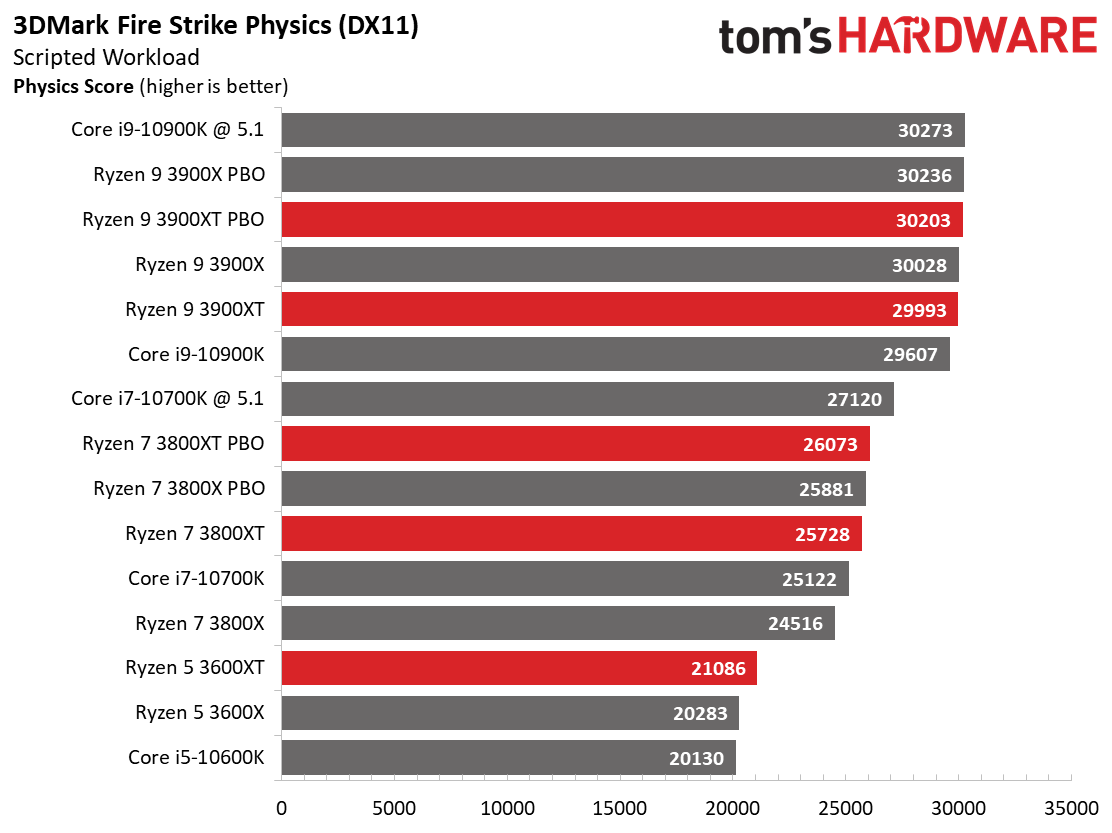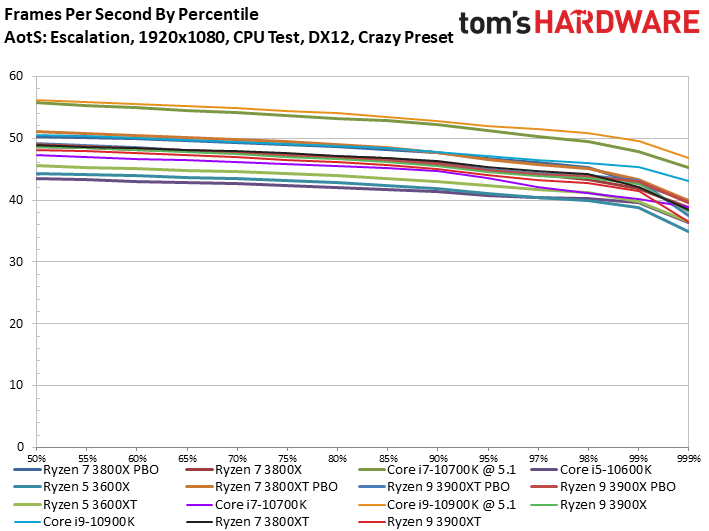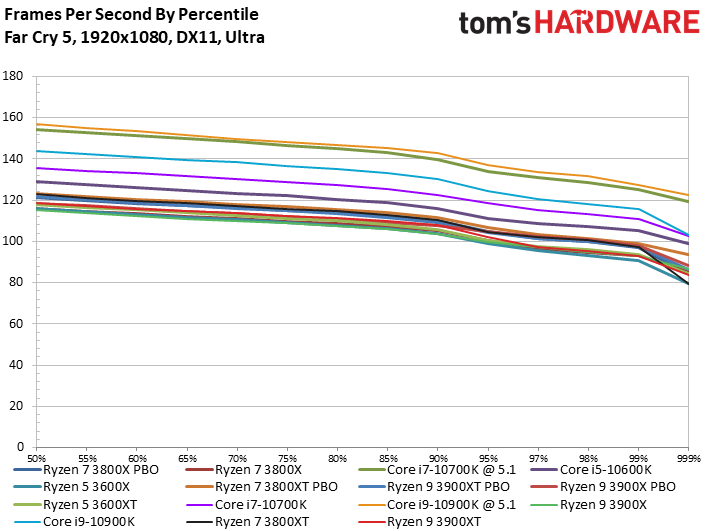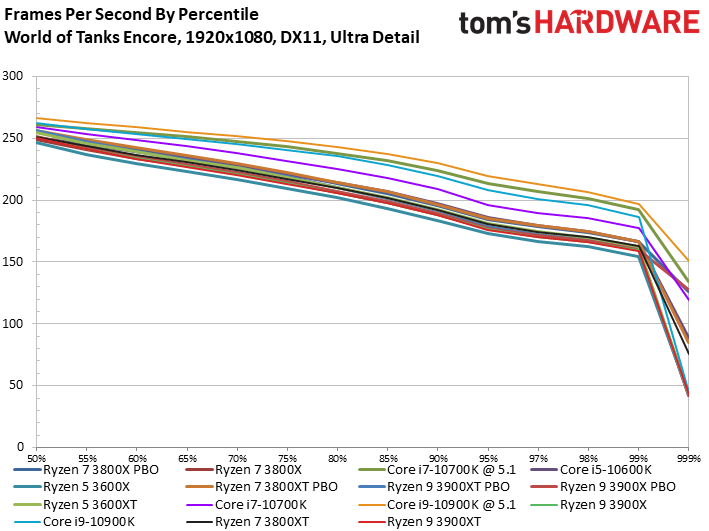Why you can trust Tom's Hardware
All test results marked with "PBO" reflect configurations tested with AMD's auto-overclocking Precision Boost Overdrive feature. For overclocking, we tuned our memory to DDR4-3600 for both Intel and AMD platforms.
We do have a limitation of 15 processors per chart (which we're addressing), so we only included the Ryzen 5 3600XT and the competing Core i5-10600K at stock settings. We'll post a separate Ryzen 5 3600XT review soon and further explore its performance with the stock cooler (we use the Corsair H115i for this testing).
The TLDR


Given the nature of the Ryzen XT refresh, we didn't expect to see large gains in gaming performance in most of the titles we tested below, and we didn't. The charts above provide the geometric mean of our gaming suite (minus the synthetic results in the first and second albums below) so we can easily identify broad trends. We can see that the Ryzen XT models are faster than their predecessors - but not by much.
In terms of average frame rates across the breadth of our test suite, the stock Ryzen 5 3600XT is 2.5% faster than the 3600X, while the Ryzen 7 3800XT and 3900XT are roughly 1% faster than their X-series counterparts. These aggregate numbers aren't impressive, but it's noteworthy that you'll see more noticeable gains in specific titles that respond best to higher clock rates. Hence, a test suite weighted more towards single-threaded performance could yield larger deltas.
As a general statement, the XT models tend to perform like their overclocked X-series counterparts. We also noticed slight performance gains over the X-series chips when we overclocked the XT models, too, but overclocked Ryzen processors generally don't yield big performance increases in gaming. We included all of our standard game testing below, but given the small performance deltas between the XT- and X-series, we won't provide too much commentary in the individual game results below (aside from identifying a few broad trends). We see more substantial performance gains in the application testing on the following pages – particularly with workstation-class applications.
We include a broader gaming breakdown with other Ryzen models added on the final page of the review, but the Ryzen XT series doesn't change AMD's standing much in the gaming landscape.
VRMark and 3DMark on AMD Ryzen 9 3900XT



Synthetic gaming benchmarks often aren't generally indicative of real-world performance, but the 3DMark DX11 and DX12 tests are interesting because they measure the amount of raw computational horsepower exposed to the game engine. For now, most of today's game engines don't scale as linearly with additional compute resources, but these tests help us gauge how games could exploit processing resources as the engines become more sophisticated.
Get Tom's Hardware's best news and in-depth reviews, straight to your inbox.
As expected, the DX11 and DX12 tests don't produce more performance from the 3900XT over the 3900X because the chip reaches its power limit under full load, which then keeps performance consistent with the X-series model. The Ryzen 7 3800XT has a bit more room to roam within the 144W power limit, so it gains 5% over the 3800X in the DX11 test. The Ryzen 5 3600XT also gains 4% in the test, but the uplift is smaller during the DX12 test.
VRMark's test values per-core performance (a mixture of frequency and IPC), and it obviously prefers physical cores and lots of L3 cache. The Ryzen 5 3600XT notches a 5% increase over its X-series counterpart, while the 3900XT gains a mere 1%. Meanwhile, we see a slight reduction for the 3800XT, but that could be due to a testing anomaly.
Civilization VI AI and Stockfish on AMD Ryzen 9 3900XT


Stockfish, an open-source chess engine, is designed to extract the utmost performance from many-core chips by scaling well up to 512 cores. Here we can see the Ryzen 9 3900XT lose a bit of steam with the PBO feature engaged, but the same is true of the Ryzen 9 3900X. Regardless, the 3900XT's twelve cores and 24 threads take the lead.
Civilization VI's AI engine values per-core performance, which benefits from Intel's higher clock rates. Except for the 3600XT, the XT models are faster than the X-series models in this benchmark. However, we do see slightly lower performance with overclocking for the 3800XT and 3900XT, but that isn't uncommon for the Ryzen 3000 series in these types of lightly-threaded tests.
Ashes of the Singularity: Escalation on AMD Ryzen 9 3900XT



Ashes of the Singularity: Escalation loves cores and threads, but clock rates also play a role. At stock settings, the Ryzen XT models experience minimal uplift over the Ryzen "X" chips. AMD says most of the performance advantages occur in lightly-threaded games that respond most to higher frequencies. This title is largely the polar opposite of that description.
In fact, the stock Ryzen 3900XT and X model tie, and the same essentially applies to the Ryzen 7 3800XT. The Ryzen 5 3600XT gains 1.2 fps over the 1600X, but that's a fairly minor increase in performance for what should be a significantly higher street price than the 3600X (we won't know actual pricing until the chips come to market).
We also see some XT-over-X gains when we engage the auto-overclocking PBO, but these are slight and could vary based upon silicon quality.
Dawn of War III on AMD Ryzen 9 3900XT



The Warhammer 40,000 benchmark responds well to threading, but it's clear that clock speed and IPC also matter. We see the same trend emerge in this benchmark, with small but measurable gains across the board for the Ryzen 9 and 7 XT chips. The 3800XT picks up 3.2 fps while the 3600XT jumps 4.1 fps over the 3600X. Meanwhile, the Ryzen 9 3900XT essentially ties itself at both stock and overclocked settings. We also don't see any overly-impressive increases in 99th percentile measurements, either.
Far Cry 5 on AMD Ryzen 9 3900XT



Far Cry 5 tends to run well on Intel architectures, which is a tendency we see as the Intel processors all beat the Ryzen competition. This is still an Intel-friendly chart, but we do see more performance from the Ryzen XT models over their predecessors. The 3800XT, for instance, provides slightly more performance than the overclocked 3800X, opening up a 6.3 fps gap between it and the 3800X. That's a pretty significant increase given the relatively small deltas between the AMD chips in this benchmark. The 3900XT notches a 3.9 fps increase over the 3900X, while the 3600XT gains 2.6 fps.
Final Fantasy XV on AMD Ryzen 9 3900XT



We run this test with the standard quality preset to sidestep the impact of a bug that causes the game engine to render off-screen objects with the higher-resolution setting.
Grand Theft Auto V on AMD Ryzen 9 3900XT



Hitman 2 on AMD Ryzen 9 3900XT



Project Cars 2 on AMD Ryzen 9 3900XT



Although Project CARS 2 is purportedly optimized for threading, clock rates obviously affect this title's frame rates.
World of Tanks enCore on AMD Ryzen 9 3900XT



MORE: Best CPUs
MORE: Intel and AMD Processor Benchmark Hierarchy
MORE: All CPUs Content
Current page: AMD Ryzen 9 3900XT Gaming Benchmarks
Prev Page AMD Ryzen 9 3900XT Boost, Thermals, Overclocking, Power Consumption Next Page AMD Ryzen 9 3900XT Application Benchmarks
Paul Alcorn is the Editor-in-Chief for Tom's Hardware US. He also writes news and reviews on CPUs, storage, and enterprise hardware.
-
jimmysmitty ReplyInvalidError said:AMD micro-binning the hell out of Zen 2.
I find it interesting yet expected. Both do this when they can. It also makes sense to remove the cooler, although Intel got hell for it, with a CPU thats designed for higher performance. Most people who build a system with top end CPUs tend to buy a third party cooler anyways and it just becomes more waste. -
King_V (sarcasm)Reply
AMD has been listening to the Intel fanboys on the forums. Higher clocks are all that matter. Included coolers are always stupid, because nobody will use them.
So, AMD offered just such an option. Ergo, having catered to what the Intel fanboys wanted, I obviously expect to see them snapping up Ryzen XT processers en-masse
(/sarcasm) -
InvalidError Reply
Part of that "hell" is for charging more despite removing the stock HSF which is in itself already an intrinsic value loss. If I'm going to get negative value for my money from ditching the stock HSF, I'll take the stock HSF even if I have no plan to actually use it.jimmysmitty said:It also makes sense to remove the cooler, although Intel got hell for it, with a CPU thats designed for higher performance. -
jimmysmitty ReplyInvalidError said:Part of that "hell" is for charging more despite removing the stock HSF which is in itself already an intrinsic value loss. If I'm going to get negative value for my money from ditching the stock HSF, I'll take the stock HSF even if I have no plan to actually use it.
They did the same thing here though.
But still the mass majority would throw the HSF away creating waste. Not worth it IMO. -
InvalidError Reply
You can flip the Prism on eBay for ~$35.jimmysmitty said:But still the mass majority would throw the HSF away creating waste. Not worth it IMO.